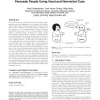Free Online Productivity Tools
i2Speak
i2Symbol
i2OCR
iTex2Img
iWeb2Print
iWeb2Shot
i2Type
iPdf2Split
iPdf2Merge
i2Bopomofo
i2Arabic
i2Style
i2Image
i2PDF
iLatex2Rtf
Sci2ools
HRI
2012
ACM
2012
ACM
Designing persuasive robots: how robots might persuade people using vocal and nonverbal cues
Social robots have to potential to serve as personal, organizational, and public assistants as, for instance, diet coaches, teacher’s aides, and emergency respondents. The success of these robots—whether in motivating users to adhere to a diet regimen or in encouraging them to follow evacuation procedures in the case of a fire—will rely largely on their ability to persuade people. Research in a range of areas from political communication to education suggest that the nonverbal behaviors of a human speaker play a key role in the persuasiveness of the speaker’s message and the listeners’ compliance with it. In this paper, we explore how a robot might effectively use these behaviors, particularly vocal and bodily cues, to persuade users. In an experiment with 32 participants, we evaluate how manipulations in a robot’s use of nonverbal cues affected participants’ perceptions of the robot’s persuasiveness and their compliance with the robot’s suggestions across four co...
| Added | 24 Apr 2012 |
| Updated | 24 Apr 2012 |
| Type | Journal |
| Year | 2012 |
| Where | HRI |
| Authors | Vijay Chidambaram, Yueh-Hsuan Chiang, Bilge Mutlu |
Comments (0)

